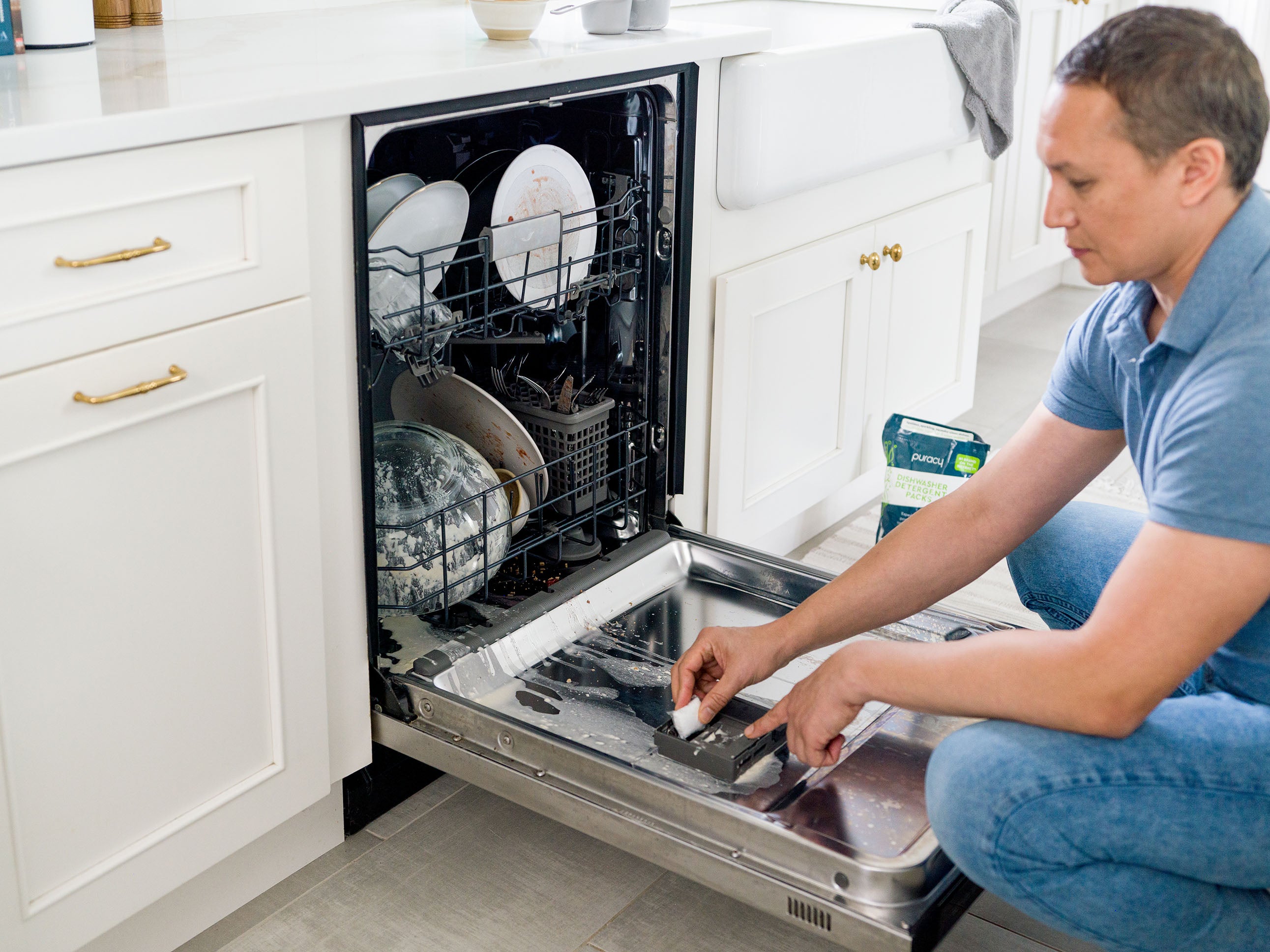
How to Clean and Disinfect Your Outdoor Carpet: A DIY Project
Cleaning an outdoor carpet requires a thorough approach to remove dirt, debris, and stains. A weekly vacuum is usually enough when it’s in a high-traffic area of the house. But a deep clean is necessary twice a year to keep it looking fresh and welcoming. The Carpet and Rug Institute recommends regular carpet cleaning, including a weekly vacuum for high-traffic areas of the house.
Step-By-Step Instructions to Clean Your Outdoor Rug

Timeframe: 1-2 hours
Skill level: Beginner
Before anything, consider these safety precautions:
- Wear protective gloves and goggles to prevent any contact with chemicals or dirt.
- Work in a well-ventilated area to avoid inhaling fumes from cleaning solutions.
- Read and follow the instructions and warnings on cleaning products carefully.
-
Get Rid of Loose Dirt From the Rug
Tools needed: Vacuum and a hand tool like a broom to beat the rug off of dirt.
If you have a small rug, you can shake it vigorously or snap it forcefully in the air to remove unwanted elements. If you have a medium-sized rug and a clothesline, you can hang the rug and beat it with a broom.
Afterward, use a vacuum or a hand vacuum to suction dirt and pet hair that has clung to the rug. If you have a large rug that might be too heavy to hang on a line, you can use a vacuum right away.
Pro tip: Choose the soft bristle attachment of your vacuum to avoid damaging the rug.
-
Pretreat Any Stains
Tools needed: an effective carpet spot remover, soft bristle brush or sponge
Inspect the carpet for any visible stains or spots. Apply a small amount of carpet cleaner or spray on the Puracy carpet spot remover. Agitate the area with a clean cloth, soft brush, or sponge.
Pro Tip: If you’re using a chemical or commercially available cleaning solution, make sure to spot test on a small area of the carpet to make sure it doesn’t discolor or damage.
-
Prepare a Powerful Yet Non-toxic Cleaning Solution
Tools needed: Hot water, an effectiveupholstery and carpet shampoo. Alternatively, you can use one to two spoonfuls of dish soap or laundry detergent.
If you are using a machine, fill the machine’s water tank with hot water and add the shampoo (1oz shampoo: 4oz of water). For larger carpets, consider using a garden sprayer to apply the cleaning solution evenly.
Pro tip: Get an outdoor cleaner that contains active ingredients like enzymes, citrus extracts, and oxygen bleach for removing tough stains and odors. For example, Puracy is a plant-based enzymatic cleaner.
-
Apply the Outdoor Carpet Cleaning Shampoo
Tools needed: Carpet shampoo, machine cleaner or a bucket of hot water if you are cleaning by hand, scrubbing or brushing tool. Apply the cleaning solution manually or using a machine. If you have a larger carpet, use a garden spray hose to make the work faster.
Using a scrub or sponge to work the solution on the carpet, but focus on the areas with stains or the heavily soiled areas.
Pro tip: Avoid saturating the carpet excessively because it may take longer to dry.
-
Rinse the Carpet
Tools needed: Garden hose with an adjustable nozzle spray.
Attach an adjustable spray nozzle to a garden hose. Thoroughly rinse the outdoor carpet, starting from one end to the other, ensuring the cleaning solution and dirt are completely washed away.
Pro Tip: Make sure to remove all the cleaning solution, as any residue left behind may attract more dirt and require additional cleaning.
-
Dry the Carpet
Tools needed: Clean towels or a squeegee. You can also use a wet/dry vacuum for larger rugs.
Use a clean towel or squeegee to remove excess water from the carpet. For large carpets, use a wet/dry vacuum to speed up the drying process. Leave the carpet in a well-ventilated area to air dry completely. This may take several hours or even a full day, depending on the weather conditions.
How to Disinfect Your Outdoor Carpet

It’s useful to regularly disinfect your rug, especially if you have pets who frequently use the rug or you accidentally spilled food or beverages on the rug. Disinfection will eliminate harmful microorganisms from the environment outside, reduce allergens, and eliminate odor.
-
Prepare the Carpet
Tools needed: Vacuum
Remove any furniture from the carpet area. Then use a broom or a vacuum cleaner to suction any dirt or debris. Use the soft brush attachment on the vacuum to gently and thoroughly remove dust particles.
-
Prepare the Disinfectant Solution
Tools needed: Bucket of warm water and disinfectant
Fill a bucket with warm water. Follow the instructions on the disinfectant cleaner or solution to prepare the appropriate dilution. Look for disinfectants that contain active ingredients such as quaternary ammonium compounds or hydrogen peroxide as they are effective against a wide range of pathogens.
-
Apply the Disinfectant Solution
Pour the disinfectant solution over the carpet or use a garden sprayer for large carpets. Use a scrub brush or sponge to work the solution into the carpet fibers, ensuring even coverage. Follow the manufacturer's instructions for the recommended contact time. This is the duration the disinfectant needs to remain on the carpet to effectively kill germs and pathogens.
Pro Tip: Consider covering the treated carpet with plastic sheeting or a tarp to prevent the disinfectant from evaporating too quickly.
-
Rinse and Allow the Carpet to Dry
Attach an adjustable spray nozzle to a garden hose. Thoroughly rinse the carpet, starting from one end to the other, ensuring all the disinfectant solution is washed away. Use a squeegee to remove excess water from the carpet or a wet/dry vacuum to speed up the drying process.
Leave the carpet in a well-ventilated space to air dry it completely to prevent mold and mildew from forming on the rug. It can take up to 24 hours to completely dry. Moisture can reactivate a musty odor from mold or mildew, even after professionally cleaning the carpet. Treat mold and mildew at the source, which may be from the backing of a carpet or a subfloor surface.
Tips to Keep Outdoor Carpets Clean

Keeping outdoor carpets clean requires regular maintenance and care to ensure their longevity and appearance. Here are some useful tips to help you keep your outdoor carpet clean:
- Regularly sweep or vacuum: A weekly sweep or vacuum of your outdoor carpet prevents the accumulation of dirt and prevents it from being ground into the fibers.
- Spot clean spills immediately: Blot the area with a clean cloth or paper towel to absorb the liquid. Avoid rubbing the spill, as it may spread the stain or push it deeper into the carpet fibers.
- Avoid harsh chemicals: Harsh chemicals, bleach, and strong detergents can damage the carpet fibers or cause discoloration.
- Prevent mold and mildew: Avoid prolonged exposure to wet conditions. If you notice mold or mildew, use a mixture of water, baking soda, and distilled white vinegar or a commercial mold and mildew cleaner to clean the affected area.
- Roll the outdoor carpet in cases of extreme weather: If you know that inclement weather is approaching, such as heavy rain or snow, consider rolling up or covering the outdoor carpet to protect it from excessive moisture and debris.


























